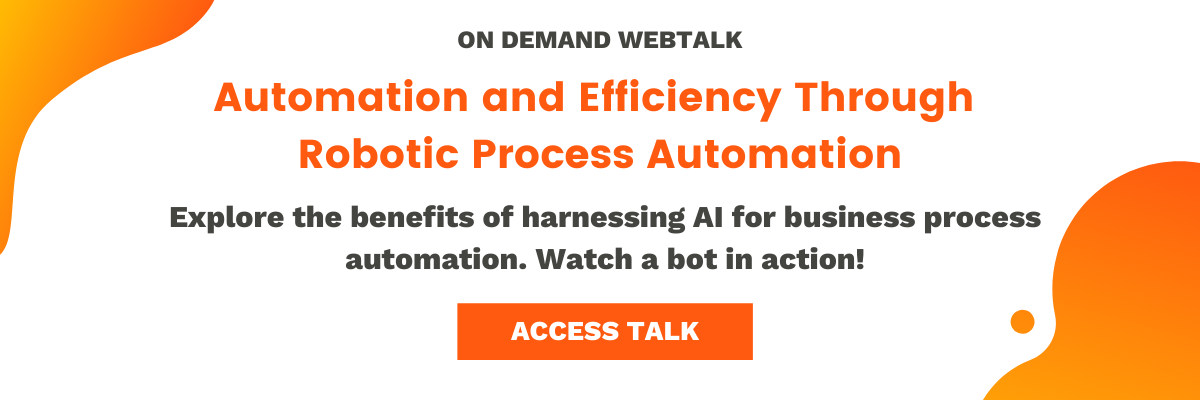Business Benefits of RPA Adoption (Robotic Process Automation)
The Age of Automation began a little over 150 years ago, with its roots firmly planted in the Industrial Revolution. The full effect of its industry wouldn’t be fully realized until years later, but the seeds were there: machines that could do the work of 100 men in an hour, removing the man in favor of the mechanism doing the same work better and faster. Granted, the Industrial Revolution is a far cry from automation, but there’s no greater historical moment to prove that machines were integral to the future of the workforce.
It wouldn’t be for over a century later, only 20 years ago from our time, that automation technologies would be fully realized in the way they were meant to be. However, despite existing for a full two decades, the majority of business processes are still manual. People are still inputting data, day in and day out, and crunching numbers that anyone or anything could crunch. Why?
Perhaps businesses are too ingrained in the old ways to make the leap to newer technologies. We get that. The thing is, progress waits for no one. Everything is rapidly changing in the digital IT transformation world thanks to huge technological advancements, none more important than AI. The impact that AI has left on the business world sets it to become the most important tool for innovation that we’ve seen since sliced bread.
Artificial intelligence has many facets to its complexity, with many versions of its variety of uses being cultured. Among these, Robotic Process Automation, or RPA, is one of those areas that is vital for supporting business growth in the modern age. Let’s talk about it a little.
What is Robotic Process Automation?
Robotic Process Automation, more easily abbreviated to RPA, is a technology application aimed at automating business processes. There are a multitude of examples of work that doesn’t necessitate human intervention to be effectively worked on. Some of these examples include deploying bots or generating automatic responses to emails, such as Gmail’s smart responses. They’re valuable tools that make our lives easier, but not important enough to put a human brain behind them.
RPA robots use the user interface to gather data and manipulate apps just like humans do. They interpret, generate responses, and communicate with other applications in order to perform repetitive tasks. You could have a human doing this work, but it would be slower and with no guarantee of high quality deliverables. The difference between the average person and an RPA robot is that one makes no mistakes and doesn’t need to sleep. That way you can have it running 24/7.
What Are the Business Benefits of RPA?
The common misconception that tends to get away with people’s imagination is that bots and RPA are here to take away the common folks’ job and put them out on the street. Perpetuating the fear that technology is here to replace us needs to die, the ideal world is one where technology does the work that doesn’t require human ingenuity, invention, and talent. Technology isn’t here to replace us, it’s to improve us.
Bots and RPA are designed to enhance people’s work, increasing productivity and ultimately lead to happier customers in the long run. Sifting through raw data isn’t suited to the human brain, but with robotics and RPA, we’re able to churn through massive quantities of information and derive meaningful stats and facts from it. That much is undoable with basic human speed and processing.
Bots are configurable software. They’re perfectly adjustable to perform repetitive tasks that you assign and can control at your own pace. With that, as AI is often programmed to do, RPA is capable of learning from the information it analyzes, which you can utilize to train them to understand, process, and facilitate larger, more complex information as you deem fit.
1. Reduce and Optimize Costs
The more full time employees you have, the more costs are going to sink into your company’s budget. Considering the mass amount of operations that you probably have going on that don’t require a human to monitor, there’s no need to hire extra bodies when you don’t need to. By automating tasks and employing bots that cost much less than a full time employee, you’re optimizing the structure of your organization.
2. Increase Labor Capacity
With pushing your more demanding grunt work into the capable hands of robots, you’re opening your options and allowing your employees to tackle more challenging prospects. You’re freeing up your most valuable resource, your everyday employee, and allocating them to focus on more sophisticated reporting and analytics. With less intensive, time-consuming work settled with RPA, you’ll find that lending your workers to flex their skill sets will lead to better decision making.
3. Improve Customer Experience
Chances are you’ve had personal experience with robots whenever you need to make an important phone call. Nine times out of ten, when you call your doctor, the bank, your service provider, or any number of other businesses, you’ll first contend with a bot who can help direct you where you need to go.
Sure, these bots aren’t perfect and can’t fill every capacity that a human can, but their work consolidates and speeds up how many clients can be effectively helped. In many cases, they’re able to speed up the employees work, allowing them to focus on nurturing clients. By being readily available to anyone and everyone, bots can provide quicker responses to customer queries or even solve issues without having to involve an employee.
4. Deliver Business Intelligence
Data collection is one of the driving pulls behind AI utility, wherein bots are capable of gathering massive amounts of information that would otherwise be left sitting under different supervision or unfeasible for humans. RPA provides tools to store valuable data for insights, reports, or task organization. Being there is no margin for human error, there are less risks for incorrect analytics, data leakage, or obsolete information. With a wider scope of data collection and analysis, there are more comprehensive insights available to benefit your business.
5. Enhance Employee Morale
Absolutely no employee likes being contracted for work below their station. There are plenty of ditches your average employee gets tossed in where they become tied up with tedious, boring work. It’s not worthwhile or appreciative of their time or effort, and by that sentiment employee morale assuredly plummets.
However, when you take advantage of robots to do the tedious tasks so your employees don’t have to, employee morale is enhanced. With boring work taken care of by RPA, you can focus your software developers performing meaningful and worthy tasks that make them feel appreciated, utilizing their skill sets and talents to their full extent. This becomes a driver in their career path and reduces their need to change jobs, simultaneously raising morale, extending opportunities, and retaining talent.
6 Levers for a Winning Automation Strategy
As much as you would like to slap an RPA into your infrastructure and call it a day, just randomly assigning your bots isn’t productive. There are steps you should take first before RPA can be used to its full effect. The following are six levers you can utilize to enact a winning automation strategy for your company.
1. PARTNER, Don’t Build
We understand the validity of wanting to create your own original products to structure your automation strategy and supplement your RPA. The problem with building your IPs in-house is that the projects are cost intensive, and often result in sub-optimal capabilities and marginal ROI. Instead of building everything on your lonesome, opt for partnering with third party RPA tools and Partners for their expertise and coverage.
2. Prepare a Business Case
The future of success is in the planning. We’re all sure you’re very excited about what RPA can offer you, but don’t let your excitement get ahead of you; you still need to compile a full business case for it. The case should be comprehensive, including business objectives, process objectives, and investment required to ensure RPA will meet and deliver to all of your expectations. Make sure to use an ROI calculator to highlight the desired outcomes that can be achieved through RPA.
3. Prioritize Processes to Automate
Not everything can or should be automated. The point of RPA is to shift off the business processes that your employees don’t need to spend their time and effort on onto the shoulders of a robot that is designed to handle it efficiently. By that token, what exactly constitutes a process that doesn’t need to be handled by a flesh and blood human?
These are the processes to prioritize for automation. To ensure everything goes smoothly, before instituting your RPA you need to identify use cases and processes to be automated in consultation with the RPA Partner by analysing data and desired outcomes. These process discovery tools can be leveraged to create a more effective infrastructure for your company.
4. Set Up an RPA Center of Excellence
Every project or initiative needs a head of expertise to guide it along the way. By setting up an RPA Center of Excellence, you’re providing a much needed hub of software developers who head the RPA, providing leadership, knowledge, and support while the RPA is included as a valuable infrastructure tool. Creating a Center of Excellence, in collaboration with the RPA Partner, allows you to carry out pilot projects, assign Partner Implementation teams to assist customers during development, and provide KPIs mutually.
5. Establish Governance Structure
Chances are there is going to be some friction in the beginning while determining how the RPA is going to function. It’s a complicated mechanism that needs governing structure to ensure every facet of its utility doesn’t go to waste. Developing the right structure is vital, which you can ensure by engaging key functions as IT, business, operations, risk, and legal teams.
While developing your governance structure and from here on out, you can be certain there will be changes made to the RPA and all its constituents. In order to properly enable change management, ensure you effectively communicate the changes and up-skill initiatives to employees in response to any and all alterations.
6. Measure Results and Fine Tune
Despite all your planning, organizing, and analysis, you’re not guaranteed to see positive results while your RPA is in use. Every initiative takes its own unique time to yield benefits, but shortcomings are a thing to take advantage of. Through an objective analysis, compare your desired outcomes with the actual outcomes, identifying shortcoming and deviations in the process. This data provides you with what you need to understand what needs changing or improving. Adjust your approach accordingly with your Partners and take corrective measures.
Conclusion
RPAs are an exciting field, but they can’t function self-sufficiently. Human guidance is still imperative to ensure the ship runs smoothly. Properly used, you can expect to see improvements in nearly every facet of your company, so long as you properly take advantage of the six levers for creating a winning automation strategy.
Automation is the future of technology and the human race. In many ways, it lays the groundwork for a utopia where people are no longer required to swelter in fields or grind away at monotonous, soul-killing, tedious workloads for their entire lives. RPA are only one part of AI that can provide massive benefits to your company, which are better applied sooner than later. Contact us and visit us at our AI Innovation Center if you’re interested in learning more about what we and AI can offer you.







Post Your Comment Here